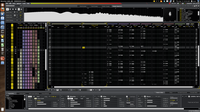Getting Into Trackers
I've been wanting to get back into writing music more regularly, and to that end I'm exploring a particular type of music composition tool called a tracker. It's about as close as you can get to writing music by editing a text file. Actually come to think of it, you can do that... maybe I'll try that someday.
Anyway, trackers got their start on 8-bit computers, and as a result they're a great way to really extract all the capabilities of the classic sound chips. They accomplish this by letting you create your own collection of instrument patches which can each combine all the available waveforms, envelopes, and filters. On the C64, for example, this means you can create your own bass drum sound by combining a white noise sound with a low triangle wave, or perhaps a sawtooth note with an intense volume envelope. Then, you take those instruments and arrange them in a pattern editor, which to the untrained eye looks like a nonsensical grid of letters and numbers. There are several C64 trackers out there, but there's one I like in particular which is both powerful and relatively easy to use, called Cybertracker.
The learning curve on trackers is pretty steep, but the reward is big: you can crank out music pretty fast once you have mastered the basics. So have a manual handy! To teach myself how to use them, I decided to write a song in a modern tracker, called Renoise. The result is below... along with a download of the original session file which you can examine yourself if you have Renoise installed. I called it "softcrunch" because I was trying to think of a word to describe the "organ" sound at the very beginning.
Modified Tuesday, May 09, 2023
